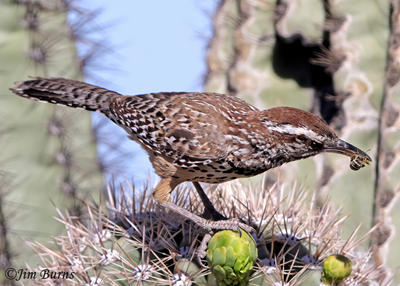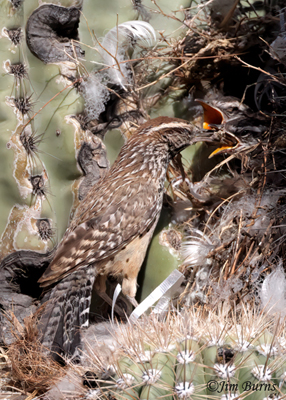
With the striking exception of our state bird, North America’s wrens are small, furtive skulkers known for their shy behavior and beautiful songs. By comparison Cactus Wrens are large, their vocalizations are harsh and guttural, and their personality is . . . well, obstreperous. If you hear raspy “buzzing” it is probably our state bird sassing you from the top of a desert bush, and last month I missed the shot of a lifetime because I didn’t instantly recognize what that buzz call meant. It was a Cactus Wren fly-hopping up the spines of a Saguaro toward an American Kestrel perched at the top. The kestrel was having none of it and abandoned its perch before the combative wren could reach it.

Cactus Wrens are obligate nest builders, meaning the male builds multiple nests nearly year round. Nests are football sized masses of sticks and weeds typically in a cholla, mesquite, or the crotch of Saguaro arms, lined with feathers, the tubular entrance at one end. The extra nests serve as dummy nests to fool predators or other desert birds, and they are used as night roosts for the male when his mate finally begins incubating in the actual breeding nest. In January, because of the season, I assumed I was observing a dummy nest being built.
Things got interesting, though, when I saw two birds bringing nesting material at the same time. It is thought Cactus Wrens mate for life, but the literature is unclear on whether the female helps with dummy nests. After several days of watching this nest construction, I observed one bird pass the other an insect morsel, and this gift exchange was followed shortly by copulation. So, maybe this nest was the conjugal nest. Let me note here that I have observed only two other species exchange food as a prelude to sex. Those would be Greater Roadrunners and humans.
After taking a break from my wrens for some travel, I was anxious to return to the scene, hoping to document them raising young. On my first visit to the site I found no activity at the nest I had observed them building, but my disappointment was soon dispelled when I found them visiting another nest in a nearby Saguaro crotch, both parents coming every twenty minutes or so with food items. I knew I had finally located an active breeding nest.
This nest was replete with human detritus too, thin green plastic streamers from god-knows-what hanging from the entrance tube, and a stark white flap of tissue paper draped over the half of the doorway on the eastern side where the rising sun first hit the cactus. Initially it seemed one of the pair lingered inside the nest for long periods which suggested hatched and unhatched eggs, but eventually both left the nest unattended and finally, as the morning wore on, I observed one parent leave with what was unmistakably a white fecal sac.
The variety of bugs on the breakfast menu was great but not surprising, insect protein comprised primarily of moths and caterpillars and, as the sun warmed up, spiders, grasshoppers, and even bees and a dragonfly. I marveled again at the ability many bird species have to capture and transport several prey items at once, and even vocalize while doing so, without dropping or losing anything. We know seabirds carry multiple fish, but insectivores like wrens have sticky tongues evolved for just this purpose.



Before I could even turn around, I heard the watchful parents buzzing. I momentarily lost sight of the roadrunners, no doubt in my mind they could catch and would eat baby wrens, but as I came around a cactus patch I was gobsmacked to see one of the roadrunners under the next bush, still twenty yards from the wrens’ new home, struggling to dispatch a four foot long California King Snake, both adult wrens sassing and circling the combatants.
It took the roadrunner twenty minutes to subdue and eat the snake as I watched, but many of the images I captured of this circle-of-life episode were photo bombed by the frantic adult wrens. It was unclear, of course, which of the two predators, bird or snake, originally set the wrens off, but it was very clear Cactus Wrens are competent parents, wise in the dangers of their desert world and well deserving of their status as Arizona’s state bird.